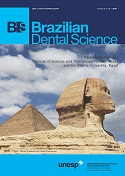Dentists’ Preferences in the Treatment of Congenitally Missing Maxillary Lateral Incisors
DOI:
https://doi.org/10.14295/bds.2019.v22i2.1710Resumo
Objective: Congenitally missing maxillary lateral incisors present challenges to dentists in terms of treatment planning and can negatively affect aesthetics and function in patients. The aim of the present study was to determine the preferred treatment approach of dentists with different specialties. Material and Methods: We carried out a descriptive, cross-sectional study using a questionnaire that was self-administered to 12 specialists in removable prosthodontics, 18 specialists in restorative dentistry, 14 specialists in orthodontics, and 173 registered general dentists. Results: General practitioners (72.7%), prosthodontists (92.9%) and, restorative dentists (80%) preferred prosthodontic replacement of missing maxillary lateral incisors, while orthodontists (57.1%) preferred canine substitution. Most general practitioners (62.7%), prosthodontists (71.4%), and orthodontists (92.9%), as well as many restorative specialists (40%), preferred implant-retained crowns for prosthetic replacement of missing lateral incisors. The dental specialties differed significantly in terms of their preferred modalities for treating children over the age of 12 years. General practitioners (56%) preferred removable partial dentures (RPDs), while a mere 17.2% preferred to carry out no treatment. All prosthodontists (100%) preferred treatment with RPDs. Restorative dentists preferred RPDs and adhesive bridges in equal number (33.3% in each case). Fifty percent of orthodontists treating children with missing lateral incisors preferred RPDs, followed by (28.6%) who preferred canine substitution. Conclusion: Preference varied for several reasons among dentists’ treating both adults and children over 12 years of age.
Keywords
Maxillary missing teeth; Dentist's preference; Teeth replacement; Dental implant.
Downloads
Downloads
Publicado
Como Citar
Edição
Seção
Licença
TRANSFERÊNCIA DE DIREITOS AUTORAIS E DECLARAÇÃO DE RESPONSABILIDADE
Toda a propriedade de direitos autorais do artigo "____________________________________________________________________" é transferido do autor(es) para a CIÊNCIA ODONTOLÓGICA BRASILEIRA, no caso do trabalho ser publicado. O artigo não foi publicado em outro lugar e não foi submetido simultaneamente para publicação em outra revista.
Vimos por meio deste, atestar que trabalho é original e não apresenta dados manipulados, fraude ou plágio. Fizemos contribuição científica significativa para o estudo e estamos cientes dos dados apresentados e de acordo com a versão final do artigo. Assumimos total responsabilidade pelos aspectos éticos do estudo.
Este texto deve ser impresso e assinado por todos os autores. A versão digitalizada deverá ser apresentada como arquivo suplementar durante o processo de submissão.




























